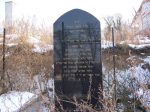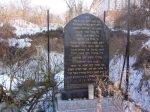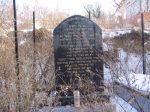Słubice was part of Frankfurt (Oder) until 1945. It is known that Jews lived in Frankfurt already in the second half of the thirteenth century. The first references of Jewish citizens date back to 1294. For many years the Jewish settlements in Frankfurt were subject to constraints. The Jews were now allowed to buy properties. Instead, they rented the premises. Economic competition with local Christians led to numerous clashes. In 1506, a local synagogue was burned down. Four years later, the local Jews were expelled from the town. These events recurred in 1573. The status of Jews in Brandenburg was upgraded in 1671 stimulating the revival of the Jewish community in Frankfurt. The local university was the first in Germany to accept Jewish students. Jews from all over Europe and even Jerusalem came to study here.
In 1801, Frankfurt was inhabited by 592 Jews. The Jewish population grew to 891 in 1880 to decline at the turn of the nineteenth century. One of the reason was emigration to the United States in an endeavour to earn a living, to Palestine and the first world war. In 1925, the Jewish population amounted to 669 and dropped steeply to 586 in 1933. Upon power takeover by the NSDAP, the Jews fell victim to acute repressions. Local rabbi Ignaz Maybaum was arrested. Jewish firms in Frankfurt went to the wall as a result of being boycotted. In 1939, the number of Jews dwindled to 168. Upon the outbreak of WWII, most of them were deported to ghettos in Lubelszczyzna. Few Jews who remained in the town were deported to Theresienstadt between 1942 and 1943. After the end of the war, the Frankfurt Jewish community revived.
The Jewish cemetery in Frankfurt was located in the area of today's Słubice at present Transportowa Street. The first reference to the cemetery dates back to July 2, 1399. That day, the town council issued a document which stated that "We, the members of Frankfurt council, state openly in this document to everybody who can see, hear or read it that the Jews bury their relatives on the Jewish Mountain (Judenberg). They should pay for it six good Czech groschen to the town". It can be assumed that the cemetery was opened much earlier and thus it is one of the oldest Jewish cemeteries in Poland. For comparison, Jewish cemeteries in Tykocin and Krakow were established as late as in the first half of the sixteenth century.
Amongst those interred in the cemetery, there is rabbi Josef Theomim, also known as Peri Megadim. He was a rabbi of Frankfurt an der Oder in the eighteenth century. His commentary on the Talmud made him famous worldwide. In the interview with the chief editor of Zielona Góra edition of Gazeta Wyborcza, Rabbi Isaac Ehrenburg described Josef Theomim in the following way: "He tutored thousands of students. He studied in Lvov, Hungary, Berlin. Finally, he was a rabbi in Frankfurt. There is no educated Jew who would not know Josef Theomim or would not read his works". For years the grave of Josef Theomim drew pious Jewish pilgrims.
The burial ground was expanded a number of times. It is known that subsequent plots were bought in 1865 and in the early twentieth century. A neo-Romantic morgue covered with a copper dome with a Star of David on its top was built in the 1870s. The cemetery was surrounded by a high brick wall.
When the second world war came to an end the cemetery was in a fairly good shape. The last burial of a known Jewish person, doctor Hermann Marcus, took place in December 1944. A year after, a few tens of German soldiers were interred here. In his document Brief history of cemetery in Frankfurt an der Oder, now in Polish town of Słubice, Eckard Reiss recalls: "On All Saints' Day in 1956, visitors from Frankfurt went for the first and last time to the Jewish cemetery in Słubice and the cemetery on embankment, they paid a visit to gardener Billerbeck and commemorated the deceased. An impossible thing afterwards. Nine years later, in 1965, I visited the Jewish cemetery for the first time. This place was overpowered by nature. Nonetheless, it was very impressive".
In the 1970s, the authorities ordered to demolish the cemetery. Gravestones were pulled out and taken to a garbage dump. The gravestones were used by some locals as rubble and are still tucked in different places. A few years ago, pieces of matzevas were found in the forest near the village of Urad. In 1976, at the initiative of party activist Tadeusz Wrzaszczyk, an inn called Zajazd Staropolski was built on the burial ground, managed by Warta Tourist enterprise. Part of the cemetery was taken up by the municipality and the Polish Coach Service (PKS). In 1999, Warta Tourist sold the inn. A new owner quickly rented the premises to a tenant who opened a night club and an escort agency there. This is one of the most outrageous examples of desecration of a Polish cemetery.
For many years, the Jews led by New York Rabbi Berel Polatsky sought to change it. In 1985, the Listed Building Protection Office in Poland considered the cemetery a listed building. In 1988, the burial ground was cleaned up by the Nissenbaum Foundation. In 1999, at the initiative of the citizens of Frankfurt and Słubice, a memorial plaque resembling matzeva was unveiled. An important turning point was the intervention of American Jews with the then Polish prime minister Leszek Miller during one of his visits to the US. Shortly afterwards, the night club was shut down and the Polish government financed the purchase of the cemetery's site.
Thanks to the efforts of the Jewish communities, three matzevas were erected to commemorate local rabbis. Inscriptions on the matzevas translate as follows:
"Here lies the rabbi and great scholar, our teacher and reb, Mr Josef, the head of rabbinical court in our community, the son of scholar, our master Meir, of blessed memory, the writer of "Porat Josef", "Ginat Wradim", commentary "Pri Megadim" on "Jore Dea", "Tewat Gama", "Szoszanat Amakim" and "Pri Megadim" on "Orach Chajim" in two volumes: "Eshel" and "Mashbecot Zahav" to name only a few. He passed away and was buried on the 4th day of Ijar of the year 552 as per shortened formula [26 April 1792]. May his soul be bounded up in the bonds of eternal life".
"Here lies an immaculate gem. He studied full Torah, bound the crowns of letters with melody. Passer-by, cry in silence, what will do those abandoned on earth who lost the tool to fight. He saved many from sin in the past days and they shed clothes and he ascended heavenward to visit the Holy G_d inside His palace. Great rabbi, our master and teacher, reb and great scholar, our master and rabbi, Mr Yehuda Lejb Margaliot, the head of the rabbinical court and yeshiva in our community, the writer of Korban Reshit, Pri Teuwa, Tal Orot, Acej Eden, Shaar Hiburim Nechmadim, the son of rabbi and great scholar, our teacher and rabbi Asher, tzadik of blessed memory. He passed away on the day of holy Shabbat, the 22nd of Sivan of the year 571 as per shortened formula" [14 June 1811].
"Happy is the one who ascends here with Talmud in hand. Here lies the son of the saints, born into the family of Rashe, Tosafist and Maharsha , and Ram, the writer of "Mapa", rabbi, sage, great scholar, righteous cabbalist our teacher and reb, Mr Zecharia Mendel from Podhajce, the son of our teacher and rabbi Lejb, the head of community of Lvov and Galicia. He was a preacher of righteousness, Kalish Chevra Caddish and Talmud Torah and never left the tent of the Torah. He tutored many apprentices in his youth and old age, the writer of Menorat Zecharia, Zecharia Meshalem and Zecharia ha-Mevin. He left behind many letters so that his sources could spread. He passed away on the third day of Chanukah of the year 552 as per shortened formula" [23 December 1791].



